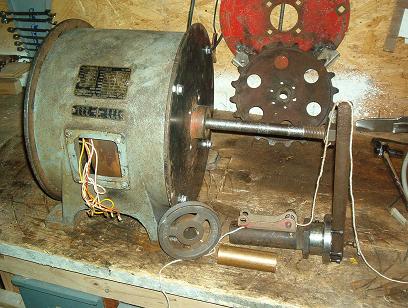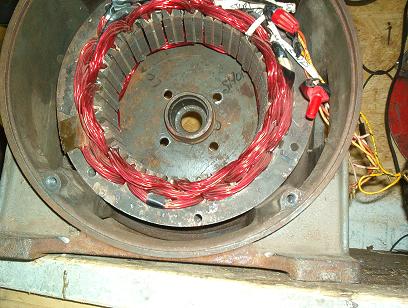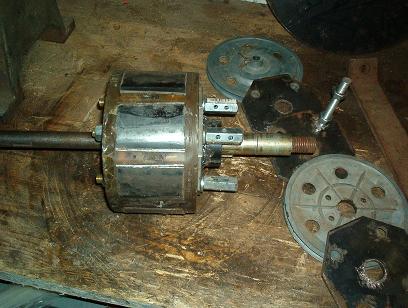This is a motor conversion from plans found in a magazine article from 25 to 30 years ago. The author's machine was rated at 1800 watts into a 36 volt battery bank. At 600 rpm he measured forty five volts and forty three amps. All he was trying to do was emulate the M Jacobs wind plant, with the variable pitch and folding tail. He was shooting for full output at 300rpm, but had to settle for a 1:2 geared step-up.
My alternator bench tested at, measuring at the output of 3 full wave rectifier's 75.5 volts dc [open voltage] and 48.5 frequencies across two of the phases, or translating 75 volts at 727 rpm. [rpm = 15*48.5][12 volts for every 115 rpm] I don't know if that is good or bad. It is a simple, good way to convert a motor but is not a perfect way.
I tried to follow the plans as much as possible. The plans call for leaving every other slot empty. I did that. You might do better to fill every slot and use smaller width magnets. Or I could, on this one, wind another 3 phases, since every other slot is empty and end up with 2 three phases alternators. I just followed the plans. Anything beyond that might not be electrically possible. The only design changes made were that the author had a 36 slot motor with six wound fields, and used two 15awg magnet wires in hand. To be fair to him he accomplished his output with only 18 coils. With my 48 slot motor you "wind up" with 24 coils and eight two inch wide magnets for the poles.
You don't know what you are getting looking at the outside of a motor. Go with what you get. I figured that with ceramic "brake drum" magnets there would not be that much current and 16awg wire, two in hand, was "good enough". There are fourteen turns of 16awg wire for each coil. I might add though my motor was not the best candidate for motor conversion as you "need a motor with a rotor diameter of at least eight to ten inches". [This is the author's opinion only]. [He felt that to have maximum output you needed a very powerful wound rotor with 500 turns of 16 or 17awg wire for each of the poles]. Looking back now I think he could have achieved his goal if he had filled every slot on his conversion. Again take what you can get. This motor is only seven and three sixteen inches across the open stator.

The magnet needs to be less than the width of a coil by at least one slot. For two inch wide magnets I wound slots one to seven, to fit the magnets, and the plans. Then wind slots seven to thirteen, etc. Eight coils per phase, twenty four coils in all. The slot that each coil leg finishes in also shares that slot with the first coil leg for the next coil in that phase. So as you wind around the stator the last coil leg of phase one shares the same slot that coil one for that phase started in. Each adjacent coil is wound in a reverse direction from the previous coil. [Clockwise, counterclockwise, etc]. With my setup [again to match the available magnets width] phase two is started by skipping a slot and starting phase two in slots three to nine, nine to.... etc. Phase three again skips a slot and starts in slot five. When you finish solder the finishes of phases one and three to the start of phase two in a star configuration. This keeps the 120 degree spacing needed for a three phase alternator. Otherwise the output will suffer across one of the phases. [5vac less at 127 rpm on mine]

The rotor end plate is made from a ¼ steel plate with the corners cut off. {As shown in the photographs] I used four of these octagons with a two inch center hole and a four bolt trailer hub pattern. By inserting all thread bolts and nuts [brass or stainless steel is nice] the two octagon end plates are held in alignment and magnet backing plates are welded under the lip to the octagon end plates. Leave the all threads in place and the other two plates with your shaft size hub
can just be bolted in place, but first have aluminum pulley's to butt against the ends of the magnets. With this setup you can interchange any shaft size at any time you want. The magnets are glued to the backing plates and the two aluminum pulley's [again with the four bolt pattern] hold them from each end. My magnets are held in place on the side by lawn chair aluminum tubing pressed flat and bent in a vise to fit the angle. Then it is fastened to the rotor by drilling and taping. The whole rotor unit was set in a form and polyester resin poured in the cracks.
There is no skewing. I can take the rotor and turn it with my thumb and forefinger. It feels like those farm duty motors you see in an agriculture store. The odd look is a result of bar iatric surgery. I tried to cut out the weight. The end bells weight twenty five lbs each and the rotor shaft adds 16 lbs. The new endplates were from a dumpster, the 7/8 shaft from a junk side sickle mower, the roller and thrust bearings from an old Ford two row corn picker. I can go back to the original shaft with a two inch hub.
